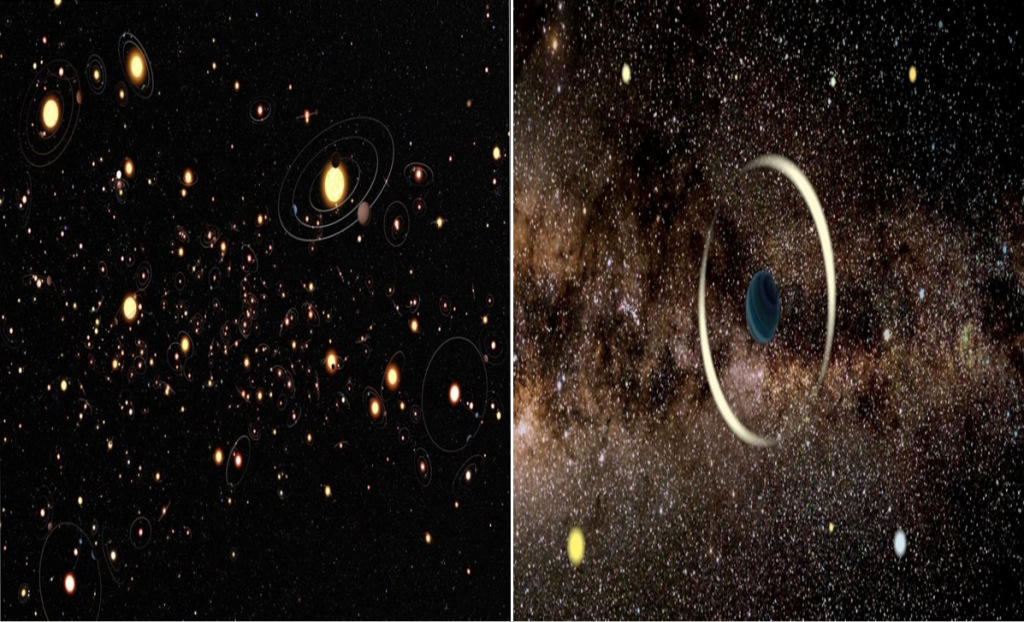
HR 5183 b: A planet with a strange orbit

HR 5183 b is an exoplanet three times the mass of the largest planet in the solarsystem: Jupiter. This unique planet has a very eccentric orbit. While most planets have circular orbits, this giant planet has an ovoid orbit.
astronomers have observed HR 5183 b for 20 years with three telescopes, but have not yet seen the planet complete its orbit.They estimate it could take anywherefrom45to100 Earth years.
Suchhighly eccentric orbits have been observed before, but mostlyfrom planets and objects much closer to their host stars.
OGLE-2016-BLG-1928: Rogue Exoplanet

Astronomers believe that in the Milky Way therecouldbe many “orphans” in the universe – planets that have escaped their parent stars andarefloating freely through the universe itself.
Exoplanets are often discoveredby their influence on their host stars, making these “homeless” planets nearly undetectable. Thisis what makes the discovery of the rogue exoplanet OGLE-2016-BLG-1928 roaming the Milky Way so special. While not the first rogue planet discovered, it is the smallestand most difficult to discover.
OGLE-2016-BLG-1928 was discovered in late 2020 using a technique called gravitational magnification.
TOI-178 planetary system: A harmonious and chaotic planetary system

At first glance, the TOI-178 planetary system might look like any other set of worlds. But a closer and longer observation shows that at least five of the system’s six worlds are locked in a rhythmic dance with each other.
The 5 outer planets have an 18:9:6:4:3 resonance. This means that when the first planet in the sequence – the planet closest to the host star compared to the other 4 – completes 18 orbits, the 2nd completes 9, the 3rd completes 6, the 4th planet completes 4 and the 5th planet – the planet furthest from the host star – completes 3.
This complex series of resonances could potentially indicate a planetary system that has not been disturbed by gravitational interactions or collisions with other systems since its formation.
However, where we find order in the universe, there is often chaos. The components of the planets that make up the TOI-178 system areopposites.Adjacent to a world with dense Earth-like soil is a low-density “soft”soilplanet, followed by an exoplanet similarin density to Neptune.
Cancri e: The Universe’s Most Valuable Exoplanet

55 Cancri e takes under 18 hours to complete one orbit and has a temperature of 2,300 degrees Celsius. The composition of this planet makes it so distinct and perhaps the most valuable object in the universe.
According to NASA , 55 Cancri e is twice the size of Earth, but has nearly nine times the mass. That has led astronomers to think that this super-Earth may consist of high-pressure carbon in the form of graphite and diamond mixed with some iron and other substances.
The estimated value of 55 Cancri e is believed to be 384 million times the Gross Domestic Product (GDP) of the Earth in 2011.
Blanets: The Extreme Planet of a Black Hole

The most extreme exoplanets may not form around stars at all, instead orbiting supermassive black holes – such planets are called blanets. They form from the gravitational collapse of overly dense regions of protoplanetary dust clouds and supermassive black holes at the centers of active galactic nuclei (AGNs).
Currently, there is no evidence that planets orbiting black holes actually exist, but dynamic modeling studies of disks of gas and dust show that under certain conditions, the formation of black holes does not exist. Planetary formation will occur in such regions.
If that were to happen, the blanets would form at a much farther distance from the black hole than most of the distance between the planets and the host star. So far that it could take 1 million Earth years for such a world to complete one orbit.






